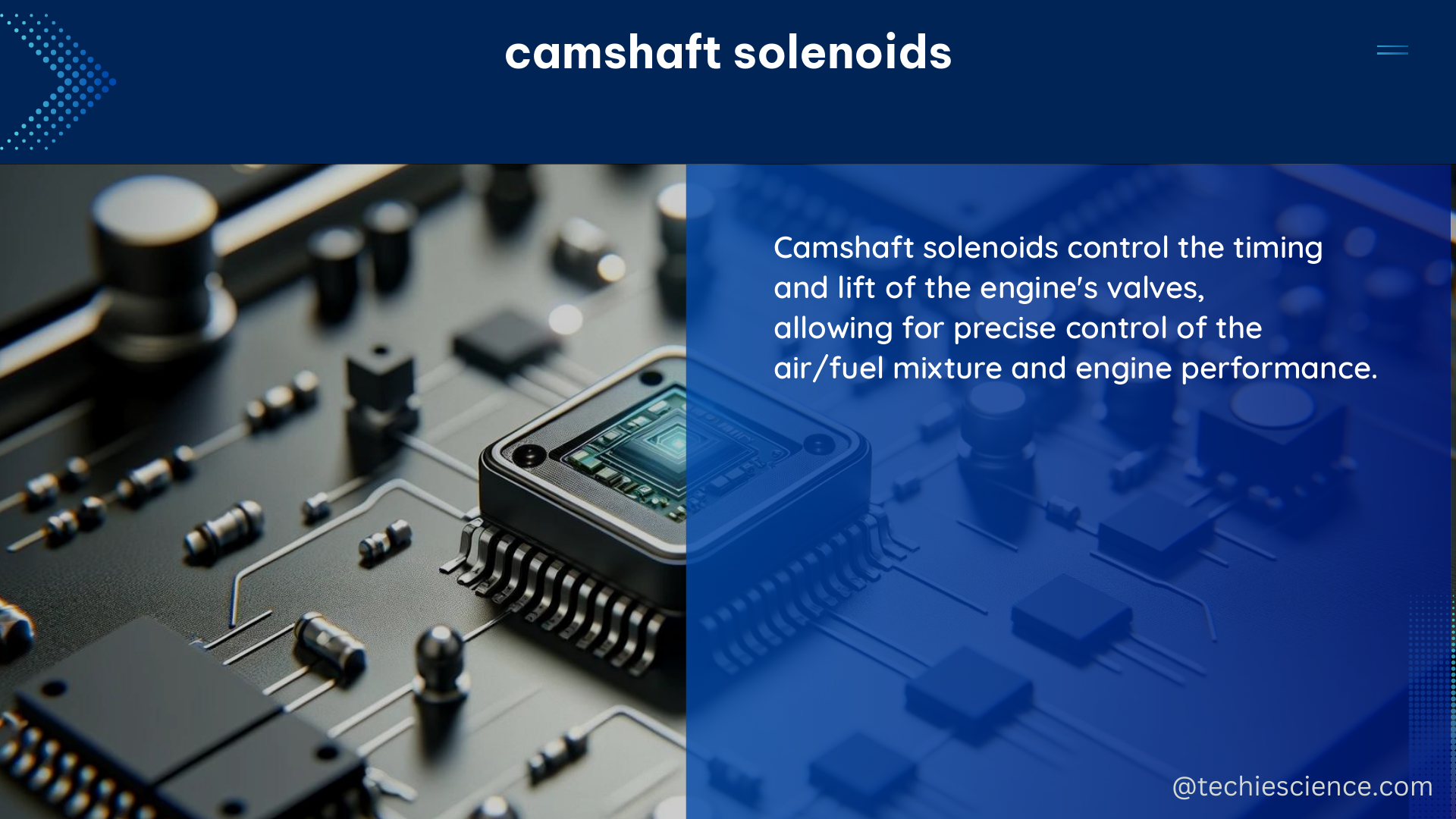Camshaft solenoids are crucial components in modern internal combustion engines, particularly in those with variable valve timing (VVT) systems. These solenoids control the flow of oil to the VVT actuators, allowing precise adjustment of the valve timing to optimize engine performance, fuel efficiency, and emissions. Understanding the technical specifications and maintenance requirements of camshaft solenoids is essential for any DIY enthusiast working on their vehicle.
Understanding Camshaft Solenoid Specifications
The technical specifications of camshaft solenoids can vary significantly depending on the engine and vehicle make and model. However, some common specifications include:
Operating Voltage
Camshaft solenoids typically operate on around 12 volts DC, although some high-performance engines may use higher voltages of up to 24 volts for faster solenoid response times. The operating voltage is crucial for ensuring the solenoid receives the necessary power to function correctly.
Operating Current
The operating current of a camshaft solenoid can range from a few hundred milliamps to several amps, depending on the solenoid’s size and resistance. Larger solenoids with lower resistance will typically draw more current, while smaller solenoids with higher resistance will draw less.
Coil Resistance
The coil resistance of a camshaft solenoid can range from a few ohms to several tens of ohms, depending on the solenoid’s size and the number of windings in the coil. The coil resistance is an important factor in determining the solenoid’s power consumption and response time.
Solenoid Travel
The solenoid travel, or the distance the solenoid plunger moves when the solenoid is energized, is typically measured in millimeters or fractions of an inch. This specification is crucial for ensuring the solenoid can effectively control the flow of oil to the VVT actuators.
Solenoid Force
The force exerted by the solenoid on the plunger is typically measured in newtons or pounds. This specification is important for determining the solenoid’s ability to overcome the resistance of the oil flow and actuate the VVT system effectively.
Tools and Equipment for Camshaft Solenoid Maintenance

To perform DIY maintenance or repair tasks on camshaft solenoids, it’s essential to have access to the appropriate tools and equipment. This may include:
| Tool/Equipment | Purpose |
|---|---|
| Digital Multimeter | Measuring voltage, current, and resistance |
| Solenoid Tester or Ohmmeter | Testing the continuity and operation of the solenoid |
| Precision Screwdrivers and Pliers | Disassembling and reassembling the solenoid |
| Clean, Well-Ventilated Workspace | Providing a safe and organized work environment |
Safety Considerations for Camshaft Solenoid Maintenance
When working with camshaft solenoids, it’s important to follow proper safety procedures to avoid injury or damage to the vehicle. This may include:
- Disconnecting the battery before working on any electrical components to prevent the risk of electrical shock.
- Wearing protective gloves and eyewear to prevent injury from sharp edges or electrical shock.
- Using insulated tools and equipment to prevent accidental contact with live electrical circuits.
- Following the manufacturer’s instructions and guidelines for servicing and repairing the solenoid to ensure proper reassembly and operation.
Troubleshooting and Repair Techniques
If a camshaft solenoid is not functioning correctly, there are several troubleshooting and repair techniques that DIY enthusiasts can employ:
- Visual Inspection: Carefully inspect the solenoid for any signs of damage, such as cracks, leaks, or corrosion.
- Electrical Testing: Use a digital multimeter to measure the solenoid’s voltage, current, and resistance to ensure they are within the manufacturer’s specifications.
- Solenoid Replacement: If the solenoid is found to be faulty, replace it with a new one that meets the same specifications as the original.
- Oil Flow Verification: Ensure that the oil flow to the VVT actuators is not obstructed, as this can also cause issues with the camshaft solenoid’s operation.
By following these steps and using the appropriate tools and equipment, DIY enthusiasts can effectively diagnose and repair issues with their vehicle’s camshaft solenoids.
Conclusion
Camshaft solenoids are critical components in modern VVT systems, and understanding their technical specifications and maintenance requirements is essential for anyone working on internal combustion engines. By following proper safety procedures and using the appropriate tools and equipment, DIY enthusiasts can perform routine maintenance and repair tasks on camshaft solenoids with confidence and skill.
References:
– NHTSA. (2021). Corporate Average Fuel Economy Standards for Model Years 2024-2026: Passenger Cars and Light Trucks. Federal Register, 86(174), 50768-51044.
– Federal Highway Administration. (n.d.). Measurement Systems Analysis Reference Manual, Fourth Edition. Retrieved from https://www.fhwa.dot.gov/policyinformation/pubs/msa_ref_manual_4th_edition.cfm
– Ford Motor Company. (n.d.). Ford Speak: Acronyms, Definitions, and Terms. Retrieved from https://www.ford.com/resources/pdf/Ford_Acronyms_Booklet.pdf

The lambdageeks.com Core SME Team is a group of experienced subject matter experts from diverse scientific and technical fields including Physics, Chemistry, Technology,Electronics & Electrical Engineering, Automotive, Mechanical Engineering. Our team collaborates to create high-quality, well-researched articles on a wide range of science and technology topics for the lambdageeks.com website.
All Our Senior SME are having more than 7 Years of experience in the respective fields . They are either Working Industry Professionals or assocaited With different Universities. Refer Our Authors Page to get to know About our Core SMEs.